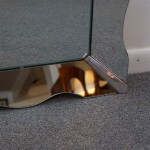Mirrors to Reflect Sunlight: Harnessing Solar Energy
Mirrors, typically associated with personal grooming and home decor, possess a remarkable ability to manipulate light. This fundamental property has led to their utilization in various scientific and technological applications, particularly in the field of solar energy. Mirrors, specifically designed to reflect sunlight, play a crucial role in concentrating solar energy, enhancing its intensity and harnessing its power to generate electricity or heat. This article explores the principles behind mirrors used to reflect sunlight, highlighting their applications and the potential they hold for a sustainable energy future.
The Science Behind Mirrors and Light Reflection
The core principle behind mirrors' ability to reflect sunlight lies in their reflective surfaces. Typically made from a material like glass or metal, these surfaces are coated with a thin layer of highly reflective material, such as silver or aluminum. When light strikes a mirror, it encounters this reflective layer, causing it to bounce back in a predictable direction. This phenomenon, known as specular reflection, is the basis for mirrors' functionality.
The angle at which light strikes the mirror, called the angle of incidence, determines the angle at which it is reflected, known as the angle of reflection. The law of reflection states that these angles are equal, ensuring that light is reflected in a predictable and controlled manner. This principle is fundamental to the design and operation of mirrors used to concentrate solar energy.
Types of Mirrors for Sunlight Concentration
Mirrors designed to reflect sunlight and concentrate its energy into a specific point are broadly categorized as:
1. Parabolic Mirrors
Parabolic mirrors are characterized by their curved, parabolic shape. When sunlight strikes a parabolic mirror, it is reflected towards a focal point located at the mirror's center of curvature. This geometry allows for a high concentration of solar energy at the focal point, making parabolic mirrors suitable for high-temperature applications such as solar thermal power plants.
2. Fresnel Lenses
Fresnel lenses, while not strictly mirrors, employ a similar principle of light redirection. They consist of a series of concentric rings, each with a slightly different curvature. These rings act as individual prisms, refracting light and directing it towards a common focal point. Unlike parabolic mirrors, Fresnel lenses are flat and can be easily scaled to large sizes, making them suitable for applications like solar concentrators and solar cookers.
3. Heliostats
Heliostats are large, computer-controlled mirrors that track the sun's movement throughout the day. They are often used in solar power plants to direct sunlight towards a central receiver, maximizing energy capture. By constantly adjusting their orientation, heliostats ensure optimal sunlight reflection and concentration, contributing to efficient energy generation.
Applications of Mirrors in Solar Energy
Mirrors designed to reflect sunlight have a wide range of applications in the realm of solar energy, including:
1. Solar Thermal Power Plants
Solar thermal power plants leverage parabolic mirrors to concentrate sunlight onto a central absorber, heating a fluid to high temperatures. This heat is then used to generate steam, which drives turbines and produces electricity. Solar thermal power plants are a promising source of renewable energy, capable of providing consistent power generation even during nighttime hours.
2. Solar Cookers
Solar cookers utilize mirrors to concentrate sunlight onto a cooking surface, generating sufficient heat for cooking food. These devices offer an alternative to conventional cooking methods, relying on renewable energy and reducing dependence on fossil fuels for cooking purposes.
3. Solar Water Heating
Mirrors can be used to heat water for domestic purposes. Solar water heaters employ mirrors to concentrate sunlight onto a water tank, raising its temperature for household use. This technology offers a sustainable solution for water heating, reducing energy consumption and reliance on conventional heating systems.
Mirrors play a pivotal role in harnessing solar energy, acting as the primary tool for concentrating and redirecting sunlight towards specific points. Their ability to enhance the intensity of sunlight opens up numerous possibilities for sustainable energy generation and innovative applications in fields like cooking, water heating, and power generation.

Sunlight Tracking Garden Mirrors Mirror

Reflecting The Sun Into Your Home Aday Io

As Mirrors Beam Light To Town Norwegians Share Patch Of Sun Npr

1b Principles And Practices Ben S Builds
Lucy Mirror Brings Natural Light Into Your Home

Viewing The Sun Safely With A Reflected Pinhole Solar Eclipse Or Transit Of Venus

Sun Reflecting Mirrors By Lula Dot Illuminate The World Interior Architecture Design Light Reflection Modern Contemporary

Giant Mirrors To Reflect Sunlight Away From Earth May Be Needed Hit Climate Targets Un Says The Independent

Can A Mirror Reflect Photons Present In Sunlight If Yes Do Plants Absorb These Reflected Or They Need Direct Quora

Using Giant Mirrors To Light Up Dark Valleys The Atlantic








